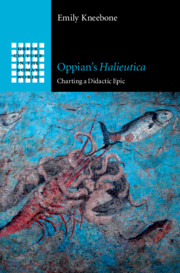Book contents
- Oppian’s Halieutica
- Greek Culture in the Roman World
- Oppian’s Halieutica
- Copyright page
- Epigraph
- Contents
- Acknowledgements
- Introduction: On Fishing
- Part I Didactic Poetry
- Part II Morality at Sea
- Part III Humans and Animals
- Chapter 7 Epic Similes
- Chapter 8 Analogical Animals
- Chapter 9 Humans and Other Animals
- Part IV The World Is a Sea
- Bibliography
- Subject Index
- Index Locorum
Chapter 9 - Humans and Other Animals
from Part III - Humans and Animals
Published online by Cambridge University Press: 24 September 2020
- Oppian’s Halieutica
- Greek Culture in the Roman World
- Oppian’s Halieutica
- Copyright page
- Epigraph
- Contents
- Acknowledgements
- Introduction: On Fishing
- Part I Didactic Poetry
- Part II Morality at Sea
- Part III Humans and Animals
- Chapter 7 Epic Similes
- Chapter 8 Analogical Animals
- Chapter 9 Humans and Other Animals
- Part IV The World Is a Sea
- Bibliography
- Subject Index
- Index Locorum
Summary
Chapter 8 has argued that the close relationship between human and non-human animals in the Halieutica is modelled in part on the linguistic and thematic similarities that associate human and animal anatomy, behaviour, psychology, and habitat in the Homeric epics. We have seen that close attention to the relationship between the two domains is a feature of Homeric poetry discussed extensively by ancient critics, and to which the Halieutica draws attention with its very first word. Yet Oppian, I now show, goes further even than Homer in blurring the boundaries between the two realms; this chapter embeds this aspect of the poem in its contemporary cultural contexts, arguing that it speaks to a wider imperial Greek fascination with the relationship between human and non-human animals, above all in the ethical and erotic spheres.
- Type
- Chapter
- Information
- Oppian's HalieuticaCharting a Didactic Epic, pp. 300 - 342Publisher: Cambridge University PressPrint publication year: 2020

